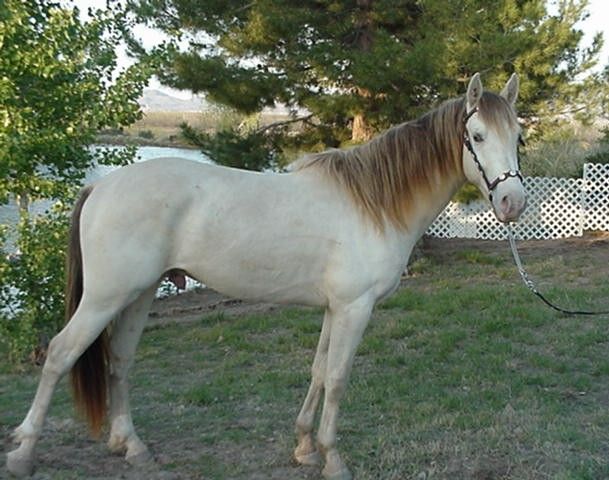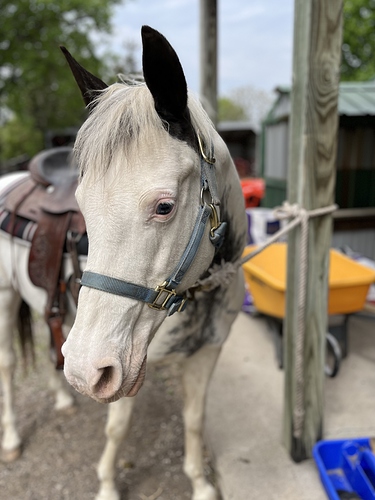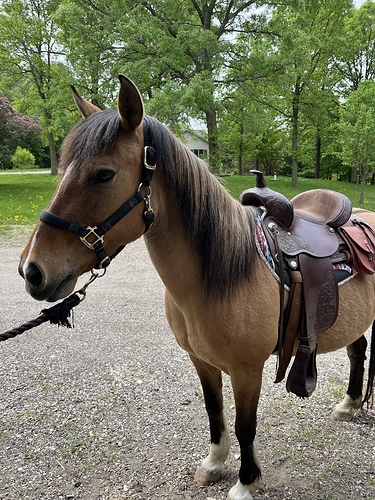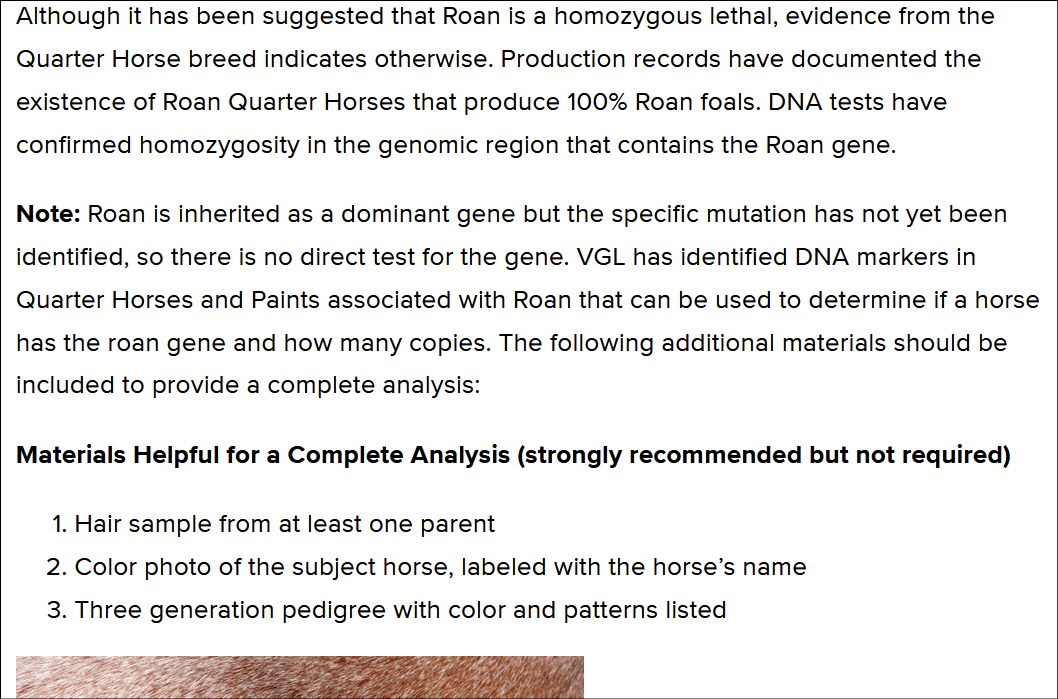Are you sure? They list “many breeds” as being suitable for testing
Ah really interesting!
Not a dun, duns have the dorsal stripe. He may just be a pale buckskin. We used to call them buttermilk buckskins back in the day.
You’d get a firmer idea of the possibilities if you knew what the dam’s parents’ colors were (what factors she may be carrying). There are also a number of different pathways to the color called chocolate palomino, including black with the silver gene, palomino with sooty, and even a flaxen liver chestnut which is just an expression of red. Find these things out and put it into an online color calculator like this one:
This mare is lots of fun…let’s see, blue roan overo paint, Medicine Hat.
And so she doesn’t feel left out, dun with leg barring, sometimes, (and curvy Mustang ears, lol). I wonder why sometimes you can see the leg barring and sometimes you can’t.
Not at my fingertips unfortunately. I’d have to search to find it.
All duns have dilution, which is a different dilution than cream. Primitive markings are not required.
https://vgl.ucdavis.edu/test/dun-horse
Chocolate Palomino is not a genetically recognized colour, but a descriptor that is used to describe anything from a dark palomino to a chestnut with flaxen to a silver black, aka as silver dapple.
It would be interesting to see test results on her! I wonder how many white patterns she has. I wouldn’t be surprised if there were 3. Tobiano, possibly Sabino (SB1) or a sabino type pattern (though most of them don’t have a test yet), either of which could give the roan type appearance, and likely one of the splash patterns. Could maybe throw frame or W20 in there too. It’s always interesting to see test results on horses with so much white.
Sorry frame Overo. Classic frame pattern
The yellow mare with the definitely gray mane and tail and yellow eyes was not a proper palomino. Her mane and tail were steel grey. I’ve never seen that before or since. Her coat was also a muted yellow, not a clear palomino. I now think she might have had something like champagne on top of buckskin. I’ve never seen a photo of this color either. I think she had a line down her back too, bit no black points.
I’ve been trying to find a good picture of a Amber Cream Champagne (the "proper term for a Buckskin with Champagne) for you to look at, but no luck yet. Nothing but foal pictures showing up asking if they are one…my eyes are starting to bleed! LOL nd1/nd can cause dorsals sometimes. It could have been that causing the dorsal. Could have been a dunalino or palomino with homozygous nd1. I wish had more pictures from when we were young!
True, but they also say
" Breeds appropriate for testing: Many breeds"
so I wonder if that’s just older text they should remove 
It was once thought that Roan was homozygous lethal, and it may still be the case for another type of Roan, but it was proven that the stock horse Roan isn’t homozygous lethal. And, there is at least one RnRn WB stallion as well.
What I have never followed up on was whether the Roan in the Belgian draft breed was definitively proven homozygous lethal. I know one older study found significantly fewer Roan offspring of R x R horses than one would expect, which would indicate embryonic lethal. I don’t know if that was proven for sure
I’ve been trying to find a good picture of a Amber Cream Champagne
https://colorgenetics.info/equine/gallery/dilutions/champagne/amber-cream-champagne-1
I found this picture as an Amber Ivory Champagne… probably a totally different catagory but interesting look.

Ohhh my, I never should’ve started reading this thread.
Can one of you experts tell me what you know about blue eyes? Not paint/white horse blue, dark blue that seem to be staying mostly blue…
There’s a three-week-old WB (Oldenburg studbook on both sides) colt locally who was born grey with dark rich blue irises. While his eyes have darkened somewhat, the lower half of his irises are still blue.
Having had a champagne mare for years, my first thought was champagne, but there’s no way on earth for a dominant gene to show up out of the blue, so to speak, right?
He’s now gone a bit tawny, has a black and grey tail, and his face is shedding a black circle around his eyes.
The UCDavis color tests seem reasonably priced to me. For a single allele, champagne for instance, it was only $40. For the whole color panel, I think it was $150.
That is a good one!
Thanks - I know several advertising as homozygous roan from testing that are neither bloodline.
Can one of you experts tell me what you know about blue eyes? Not paint/white horse blue, dark blue that seem to be staying mostly blue…
There’s a three-week-old WB (Oldenburg studbook on both sides) colt locally who was born grey with dark rich blue irises. While his eyes have darkened somewhat, the lower half of his irises are still blue.
dark blue is common in newborns. If the lower half is still that dark blue, it will fade into his adult color as well. Sometimes part of an iris will be that lighter blue associated with white patterns, either just as a natural deviation, or as a function of some white pattern, visible or not
Having had a champagne mare for years, my first thought was champagne, but there’s no way on earth for a dominant gene to show up out of the blue, so to speak, right?
Correct, dominant genetics can’t hide (barring things like a double dilute or max white also being gray, something like that). And Champagne eyes are a different kind of blue
True, but they also say
" Breeds appropriate for testing: Many breeds"
so I wonder if that’s just older text they should remove
Agreed. Even the Pepto line of QHs (cutting) don’t “test” roan by their marker testing. Their website is simplified to be annoying to some who study equine genetics from what I’ve read. By many who ever wrote the test could be referring to all stockhorse breeds and their crosses. 
Thanks - I know several advertising as homozygous roan from testing that are neither bloodline.
If they are Pepto lines, it could be possible, but not confirmable as far as I can tell. What are the bloodlines?
When I was at UConn they had a black Morgan born - with blue eyes. They remained blue for the two years I knew him. At the time, he couldnt be registered due to the eyes. They named him Neon. 
When I was at UConn they had a black Morgan born - with blue eyes. They remained blue for the two years I knew him. At the time, he couldnt be registered due to the eyes. They named him Neon.
That is crazy he couldn’t be registered. White patterns do crazy things even if they aren’t obvious. Love the name though!




